Primary Frequency Response Improvement in Interconnected Power Systems Using Electric Vehicle Virtual Power Plants
Abstract
1. Introduction
- Proposing of electric vehicle aggregator for frequency studies.
- Suggesting electric vehicle contribution in the provision of ancillary services for smart grids.
- Proposing virtual power plant based on the available electric vehicle stored reserves.
- Improving the primary frequency response in power systems using vehicle-to-grid technique.
- Suggesting a simple and accurate frequency response model for future power system studies.
- Testing the proposed method on real-world power system.
2. Primary Frequency Control
2.1. Virtual Power Plant Overview
- Market-Based Virtual Power Plant (MBVPP)
- Generic Virtual Power Plant (GVPP)
- Commercial Virtual Power Plant (CVPP)
- Technical Virtual Power Plant (TVPP)
- Environmental Virtual Power Plant (EVPP)
- Electric Vehicle Virtual Power Plant (EV-VPP)
- Centralized Controlled Virtual Power Plant (CCVPP)
- Distributed Controlled Virtual Power Plant (DCVPP)
- Fully Distributed Controlled Virtual Power Plant (FDCVPP)
2.2. Frequency Control Overview
3. Online EV-Based VPP for Primary Reserve
3.1. Multi Agent EV Based Online VPP
3.2. Primary Reserve Calculation
- Group 1 constraints:If {Connected EV to the grid status: NO) Or (Connected EV to the grid status: YES; and ()}, Then put EV in Group 1.
- Group 2 constraints:If {Connected EV to the grid status: YES; and ()} Then place EV in Group 2.
- Group 3 constraints:If Connected EV to the grid status: YES; and (Charging status: idle), Then place EV in Group 3.
- Group 1 does not provide any primary reserve to the power system.
- EVs in Group 2 provide primary reserve by stopping their charge and injecting their power back into grid as followswhere , , and are the primary reserve from all EVs in group 2, the number of EVs in group 2, and the maximum EV charging power rate in [kW], respectively. It is worth mentioning that the number 2 in Equation (1) is added because the electric vehicles in this group participate to frequency control not only by stopping their charging power, but also by injecting some of the stored electric energy in their batteries into the electric power grid.
- EVs in group 3 provide primary reserve for primary frequency control by discharging their power only as followswhere , and are the primary reserve from EVs in group 3 and the number of EVs in group 3, respectively.
4. EV Dynamic Model for Frequency Evaluation
5. The Case Study System
6. Simulations and Discussions
7. Comparison Study
8. Conclusions
Author Contributions
Funding
Acknowledgments
Conflicts of Interest
Abbreviations
| EV | Electric vehicle |
| VPP | Virtual power plant |
| SOC | State of charge |
| LFC | Load frequency control |
| DG | Distributed generation |
| MBVPP | Market-Based Virtual Power Plant |
| GVPP | Generic Virtual Power Plant |
| CVPP | Commercial Virtual Power Plant |
| TVPP | Technical Virtual Power Plant |
| EVPP | Environmental Virtual Power Plant |
| EV-VPP | Electric Vehicle Virtual Power Plant |
| CCVPP | Centralized Controlled Virtual Power Plant |
| DCVPP | Distributed Controlled Virtual Power Plant |
| FDCVPP | Fully Distributed Controlled Virtual Power Plant |
| H | All synchronous machines in the system |
| D | The frequency sensitivity load-damping |
Appendix A. Parameters of the Studied Power System Model
References
- Lee, M.; Aslam, O.; Foster, B.; Kathan, D.; Kwok, J.; Medearis, L.; Palmer, R.; Sporborg, P.; Tita, M. Assessment of Demand Response and Advanced Metering; Technical Report; Federal Energy Regulatory Commission: Washington, DC, USA, 2013. [Google Scholar]
- Blaabjerg, F.; Teodorescu, R.; Liserre, M.; Timbus, A.V. Overview of control and grid synchronization for distributed power generation systems. IEEE Trans. Ind. Electr. 2006, 53, 1398–1409. [Google Scholar] [CrossRef]
- Gevorgian, V.; Zhang, Y.; Ela, E. Investigating the impacts of wind generation participation in interconnection frequency response. IEEE Trans. Sustain. Energy 2014, 6, 1004–1012. [Google Scholar] [CrossRef]
- Pearmine, R.; Song, Y.; Chebbo, A. Influence of wind turbine behaviour on the primary frequency control of the British transmission grid. IET Renew. Power Gener. 2007, 1, 142–150. [Google Scholar] [CrossRef]
- Kundur, P.; Balu, N.J.; Lauby, M.G. Power System Stability and Control; McGraw-Hill: New York, NY, USA, 1994; Volume 7. [Google Scholar]
- Bevrani, H.; Hiyama, T. Intelligent Automatic Generation Control; CRC Press: Boca Raton, FL, USA, 2016. [Google Scholar]
- Haes Alhelou, H.; Hamedani Golshan, M.E.; Hajiakbari Fini, M. Wind driven optimization algorithm application to load frequency control in interconnected power systems considering GRC and GDB nonlinearities. Electr. Power Compon. Syst. 2018, 46, 1223–1238. [Google Scholar] [CrossRef]
- Fini, M.H.; Yousefi, G.R.; Alhelou, H.H. Comparative study on the performance of many-objective and single-objective optimisation algorithms in tuning load frequency controllers of multi-area power systems. IET Gener. Trans. Distrib. 2016, 10, 2915–2923. [Google Scholar] [CrossRef]
- Alhelou, H.H.; Golshan, M.H.; Askari-Marnani, J. Robust sensor fault detection and isolation scheme for interconnected smart power systems in presence of RER and EVs using unknown input observer. Int. J. Electr. Power Energy Syst. 2018, 99, 682–694. [Google Scholar] [CrossRef]
- Alhelou, H.H.; Hamedani-Golshan, M.E.; Heydarian-Forushani, E.; Al-Sumaiti, A.S.; Siano, P. Decentralized fractional order control scheme for LFC of deregulated nonlinear power systems in presence of EVs and RER. In Proceedings of the 2018 International Conference on Smart Energy Systems and Technologies (SEST), Sevilla, Spain, 10–12 September 2018; pp. 1–6. [Google Scholar]
- Alhelou, H.H.; Golshan, M.E.H.; Hatziargyriou, N.D. A decentralized functional observer based optimal LFC considering unknown inputs, uncertainties, and cyber-attacks. IEEE Trans. Power Syst. 2019, 34, 4408–4417. [Google Scholar] [CrossRef]
- Alhelou, H.H.; Golshan, M.E.H.; Hatziargyriou, N.D. Deterministic dynamic state estimation-based optimal LFC for interconnected power systems using unknown input observer. IEEE Trans. Smart Grid 2019, 11, 1582–1592. [Google Scholar] [CrossRef]
- Alhelou, H.H.; Golshan, M. Decision-making-based optimal generation-side secondary-reserve scheduling and optimal LFC in deregulated interconnected power system. In Decision Making Applications in Modern Power Systems; Elsevier: Amsterdam, The Netherlands, 2020; pp. 269–299. [Google Scholar]
- Njenda, T.C.; Golshan, M.; Alhelou, H.H. WAMS based intelligent under frequency load shedding considering online disturbance estimation. In Proceedings of the 2018 Smart Grid Conference (SGC), Sanandaj, Iran, 28–29 November 2018; pp. 1–5. [Google Scholar]
- Haes Alhelou, H.; Hamedani Golshan, M.E.; Njenda, T.C.; Siano, P. Wams-based online disturbance estimation in interconnected power systems using disturbance observer. Appl. Sci. 2019, 9, 990. [Google Scholar] [CrossRef]
- Haes Alhelou, H.; Hamedani-Golshan, M.E.; Njenda, T.C.; Siano, P. Wide-area measurement system-based optimal multi-stage under-frequency load-shedding in interconnected smart power systems using evolutionary computing techniques. Appl. Sci. 2019, 9, 508. [Google Scholar] [CrossRef]
- Alhelou, H.H.; Hamedani-Golshan, M.E.; Zamani, R.; Heydarian-Forushani, E.; Siano, P. Challenges and opportunities of load frequency control in conventional, modern and future smart power systems: A comprehensive review. Energies 2018, 11, 2497. [Google Scholar] [CrossRef]
- Haes Alhelou, H.; Hamedani-Golshan, M.E.; Njenda, T.C.; Siano, P. A survey on power system blackout and cascading events: Research motivations and challenges. Energies 2019, 12, 682. [Google Scholar] [CrossRef]
- Baboli, P.T.; Moghaddam, M.P.; Fallahi, F. Utilizing electric vehicles on primary frequency control in smart power grids. In Proceedings of the International Conference Petroleum and Sustainable Develop, Dubai, United Arab Emirates, 28–30 December 2011; pp. 6–10. [Google Scholar]
- Tomić, J.; Kempton, W. Using fleets of electric-drive vehicles for grid support. J. Power Sour. 2007, 168, 459–468. [Google Scholar] [CrossRef]
- Pillai, J.R.; Bak-Jensen, B. Vehicle-to-grid systems for frequency regulation in an Islanded Danish distribution network. In Proceedings of the 2010 IEEE Vehicle Power and Propulsion Conference, Lille, France, 1–3 September 2010; pp. 1–6. [Google Scholar]
- Izadkhast, S.; Garcia-Gonzalez, P.; Frías, P. An aggregate model of plug-in electric vehicles for primary frequency control. IEEE Trans. Power Syst. 2014, 30, 1475–1482. [Google Scholar] [CrossRef]
- Mu, Y.; Wu, J.; Ekanayake, J.; Jenkins, N.; Jia, H. Primary frequency response from electric vehicles in the Great Britain power system. IEEE Trans. Smart Grid 2012, 4, 1142–1150. [Google Scholar] [CrossRef]
- Alhelou, H.S.H.; Golshan, M.; Fini, M.H. Multi agent electric vehicle control based primary frequency support for future smart micro-grid. In Proceedings of the 2015 Smart Grid Conference (SGC), Tehran, Iran, 22–23 December 2015; pp. 22–27. [Google Scholar]
- Liu, H.; Hu, Z.; Song, Y.; Lin, J. Decentralized vehicle-to-grid control for primary frequency regulation considering charging demands. IEEE Trans. Power Syst. 2013, 28, 3480–3489. [Google Scholar] [CrossRef]
- Pudjianto, D.; Ramsay, C.; Strbac, G. Virtual power plant and system integration of distributed energy resources. IET Renew. Power Gener. 2007, 1, 10–16. [Google Scholar] [CrossRef]
- Jansen, B.; Binding, C.; Sundstrom, O.; Gantenbein, D. Architecture and communication of an electric vehicle virtual power plant. In Proceedings of the 2010 First IEEE International Conference on Smart Grid Communications, Gaithersburg, MD, USA, 4–6 October 2010; pp. 149–154. [Google Scholar]
- Raab, A.; Ferdowsi, M.; Karfopoulos, E.; Unda, I.G.; Skarvelis-Kazakos, S.; Papadopoulos, P.; Abbasi, E.; Cipcigan, L.; Jenkins, N.; Hatziargyriou, N.; et al. Virtual power plant control concepts with electric vehicles. In Proceedings of the 2011 16th International Conference on Intelligent System Applications to Power Systems, Hersonissos, Greece, 25–28 September 2011; pp. 1–6. [Google Scholar]
- Alhelou, H.H.; Golshan, M. Hierarchical plug-in EV control based on primary frequency response in interconnected smart grid. In Proceedings of the 2016 24th Iranian Conference on Electrical Engineering (ICEE), Shiraz, Iran, 10–12 May 2016; pp. 561–566. [Google Scholar]
- Galus, M.D.; Koch, S.; Andersson, G. Provision of load frequency control by PHEVs, controllable loads, and a cogeneration unit. IEEE Trans. Indust. Electron. 2011, 58, 4568–4582. [Google Scholar] [CrossRef]
- You, S.; Træholt, C.; Poulsen, B. A market-based virtual power plant. In Proceedings of the 2009 International Conference on Clean Electrical Power, Capri, Italy, 9–11 June 2009; pp. 460–465. [Google Scholar]
- Barata, P.N.A.; Ribeiro Filho, M.; Nunes, M.V.A. Consolidating learning in power systems: Virtual reality applied to the study of the operation of electric power transformers. IEEE Trans. Educ. 2015, 58, 255–261. [Google Scholar] [CrossRef]
- Dimeas, A.L.; Hatziargyriou, N.D. Operation of a multiagent system for microgrid control. IEEE Trans. Power Syst. 2005, 20, 1447–1455. [Google Scholar] [CrossRef]
- Zhao, Y.; Hu, X.H.; He, Z.Y.; Tang, G.F. A study of mathematic modeling of VSC for electromechanical transient analysis. In Proceedings of the 2008 China International Conference on Electricity Distribution, Guangzhou, China, 10–13 December 2008; pp. 1–6. [Google Scholar]
- Jaganathan, S.; Gao, W. Battery charging power electronics converter and control for plug-in hybrid electric vehicle. In Proceedings of the 2009 IEEE Vehicle Power and Propulsion Conference, Dearborn, MI, USA, 7–10 September 2009; pp. 440–447. [Google Scholar]

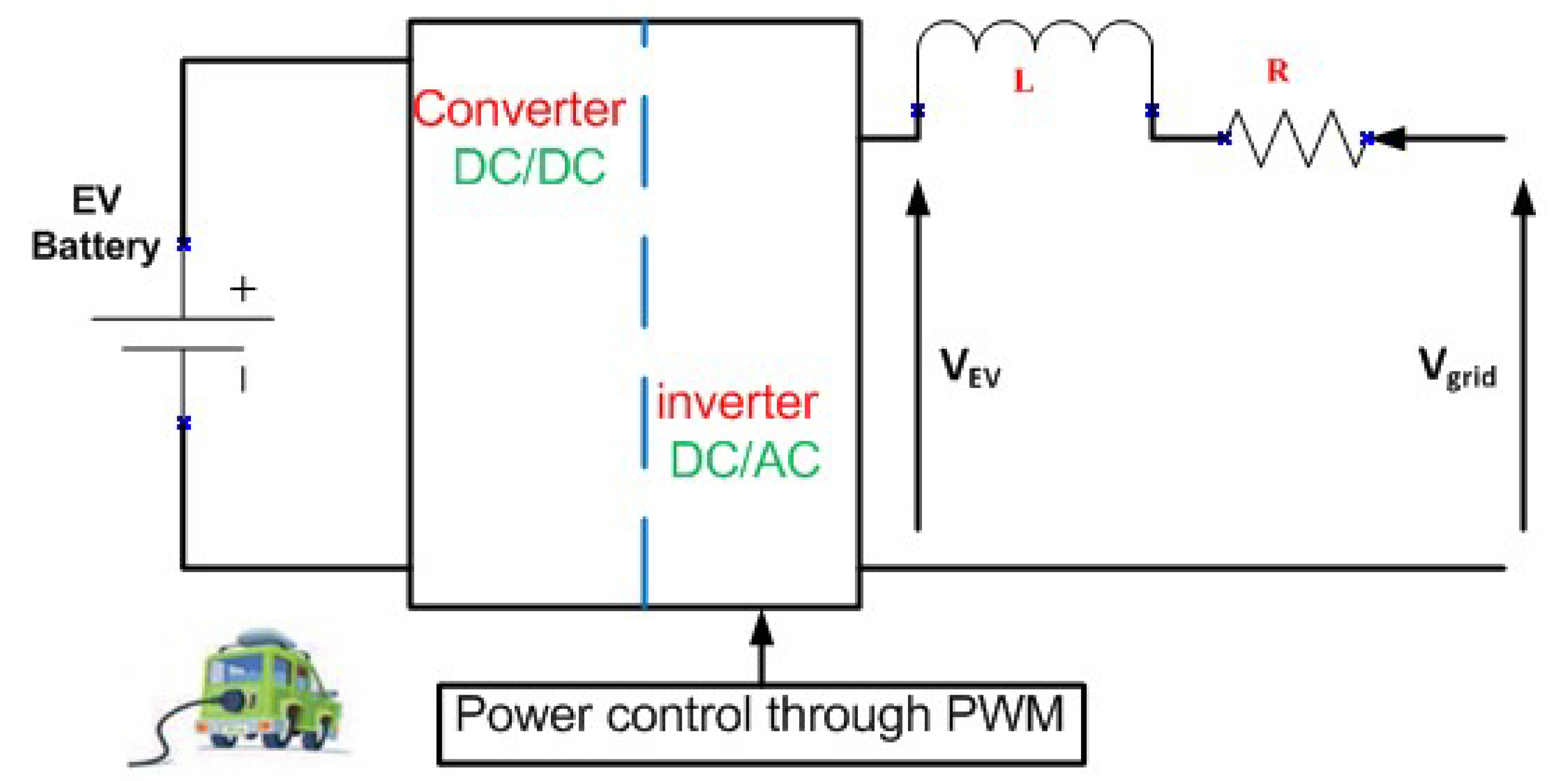

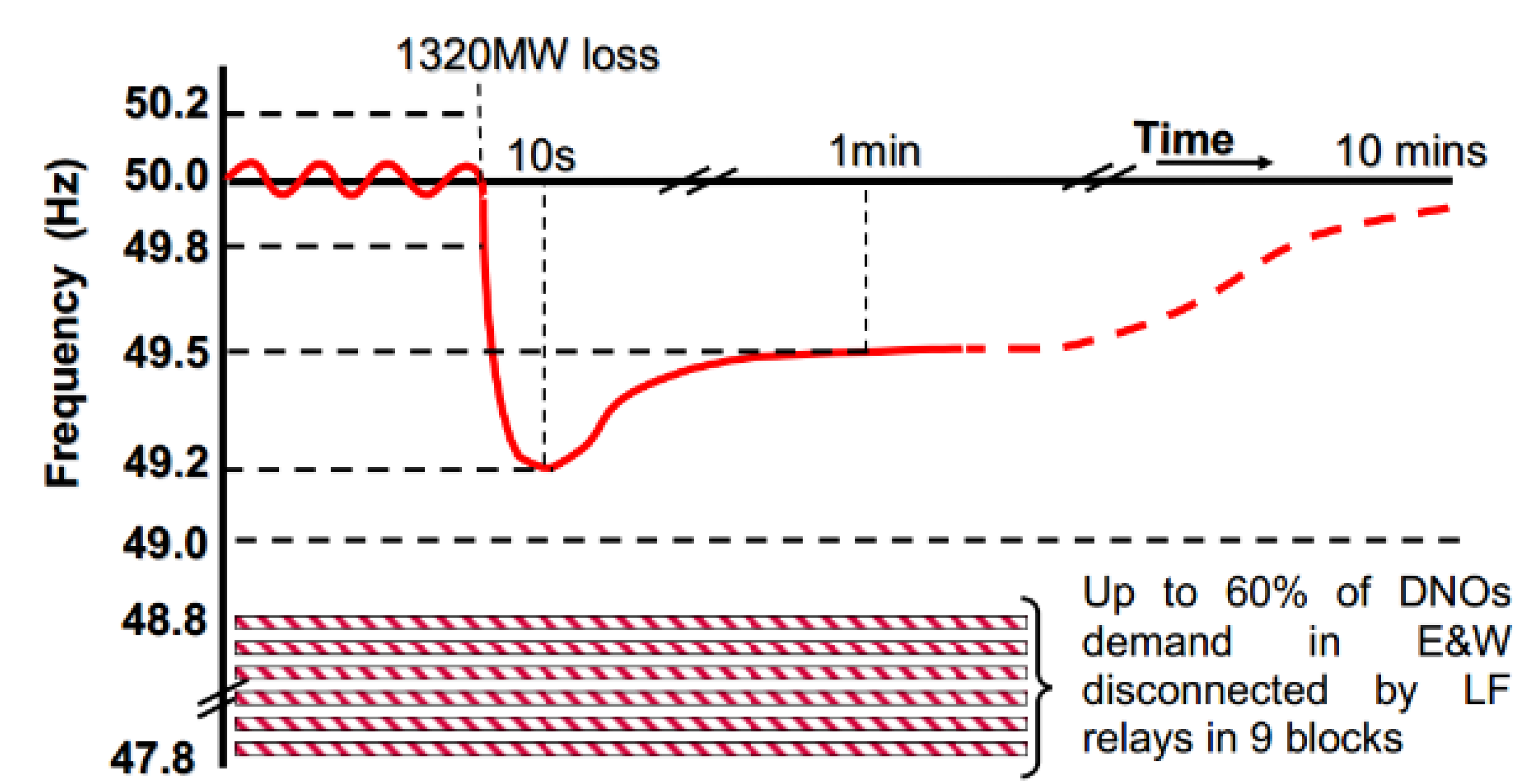
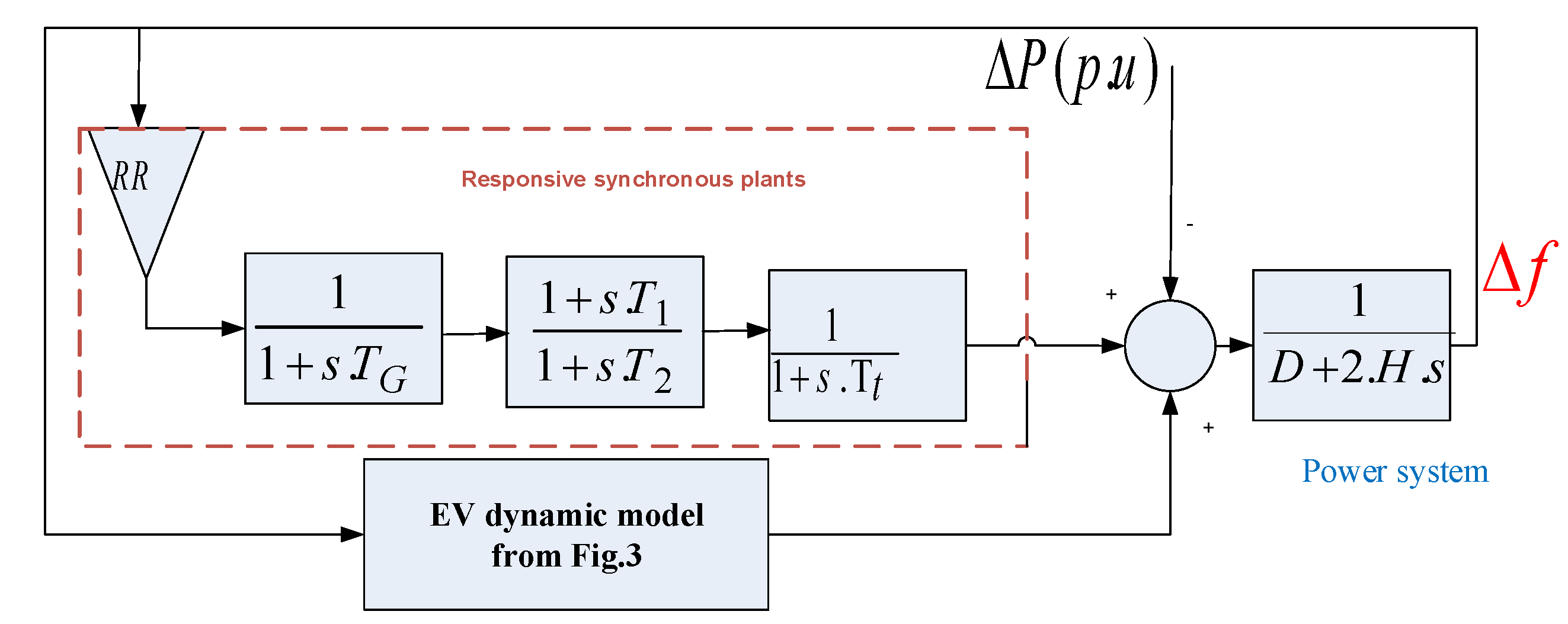
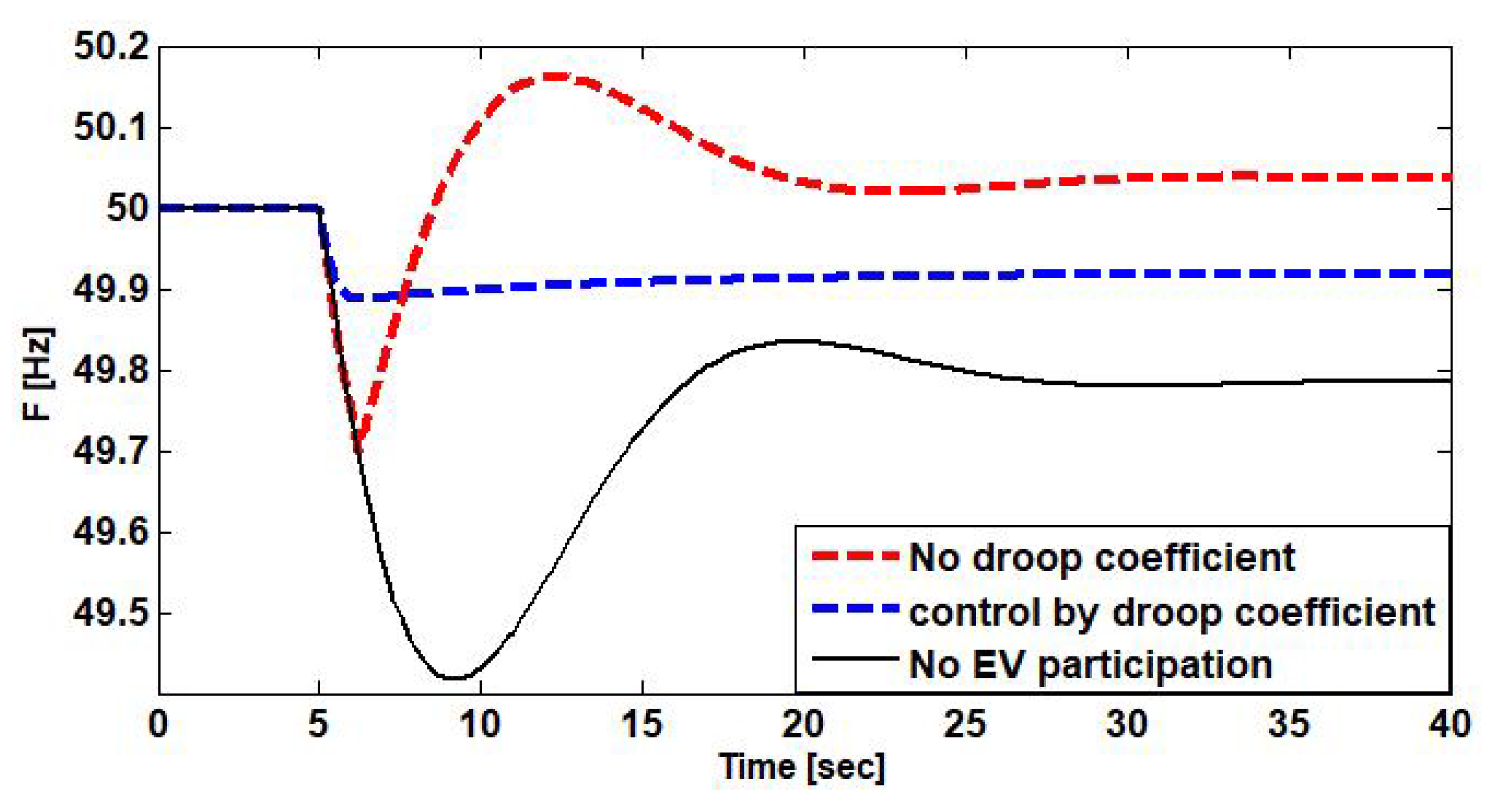
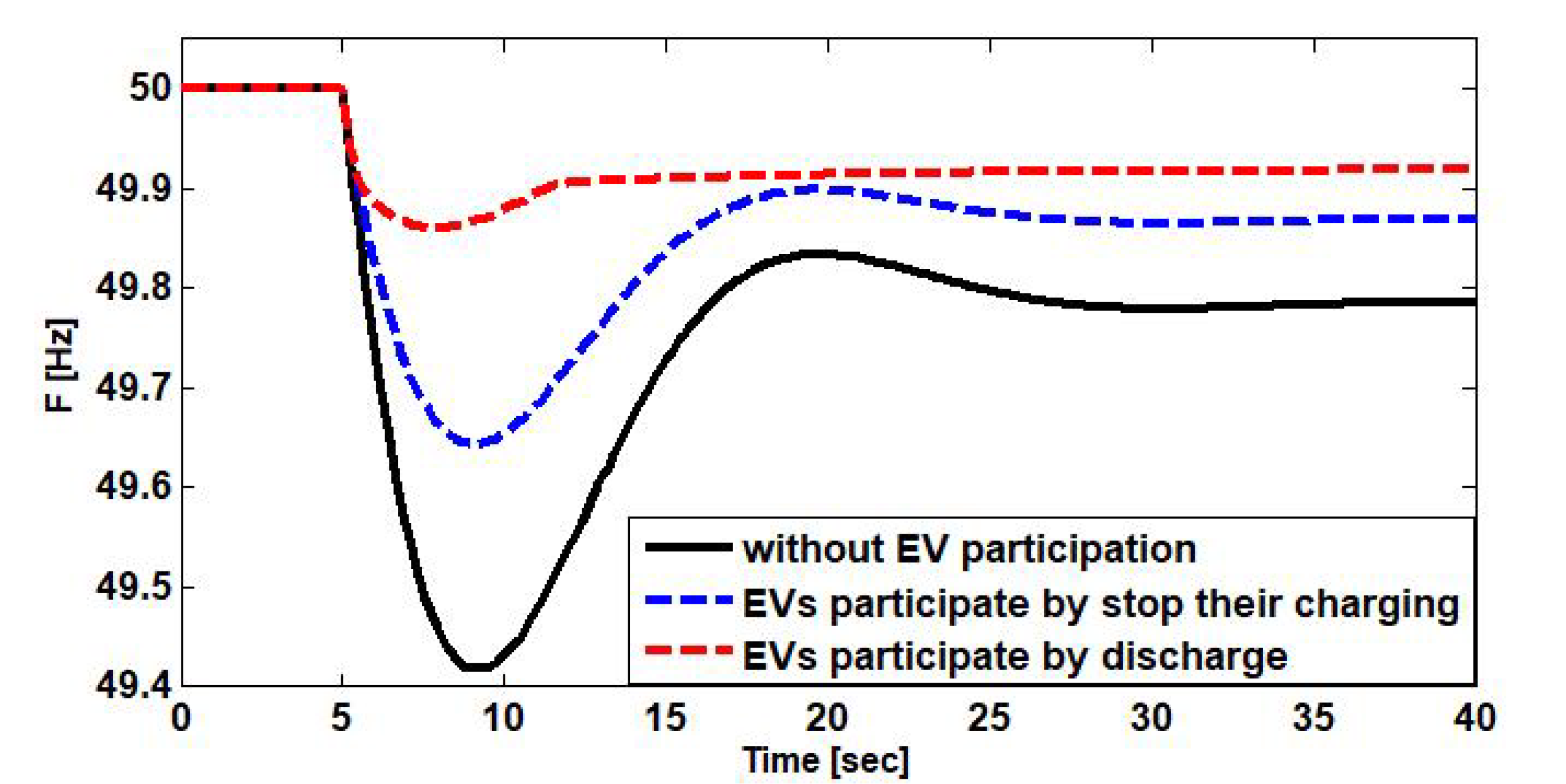
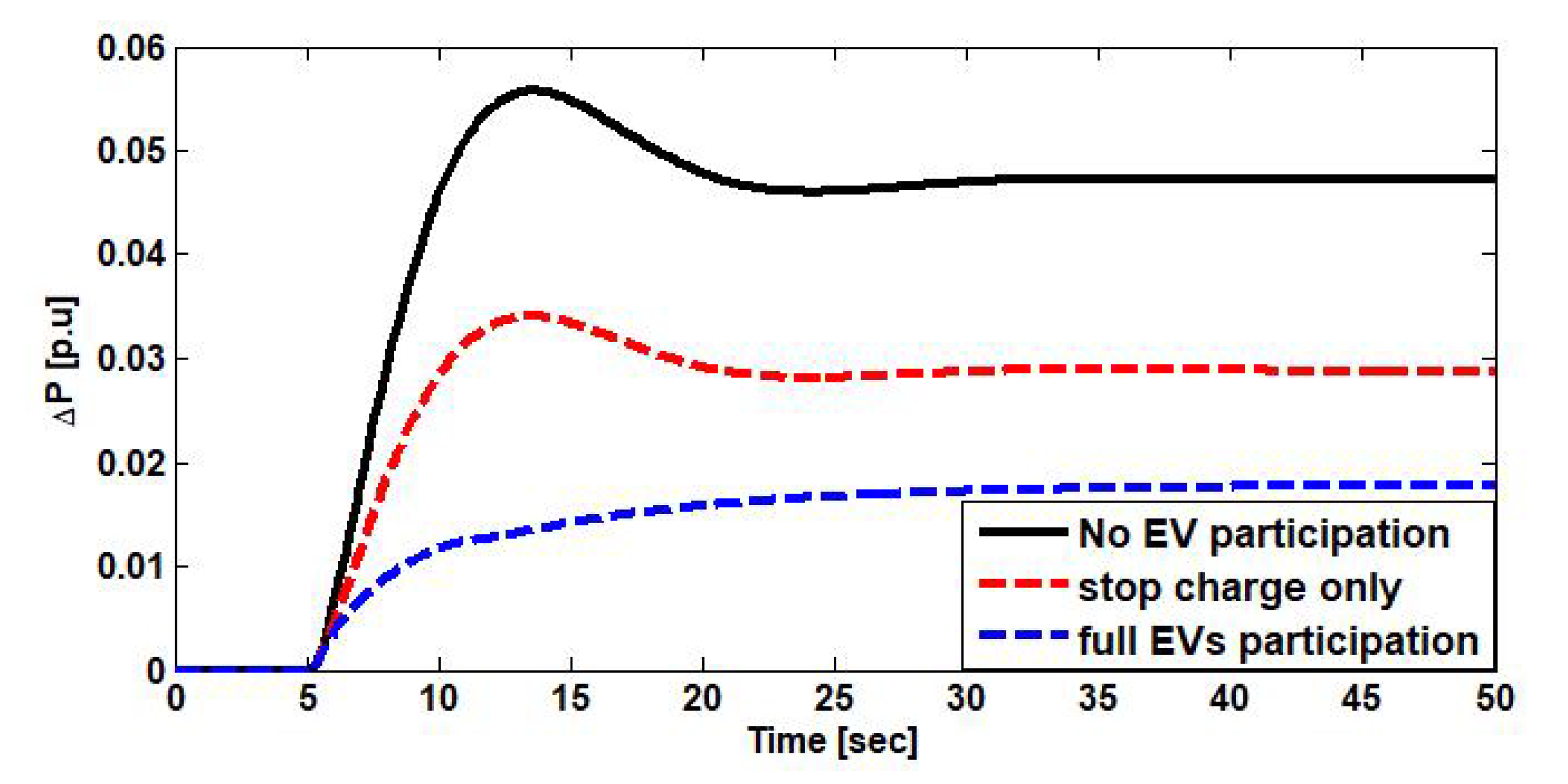
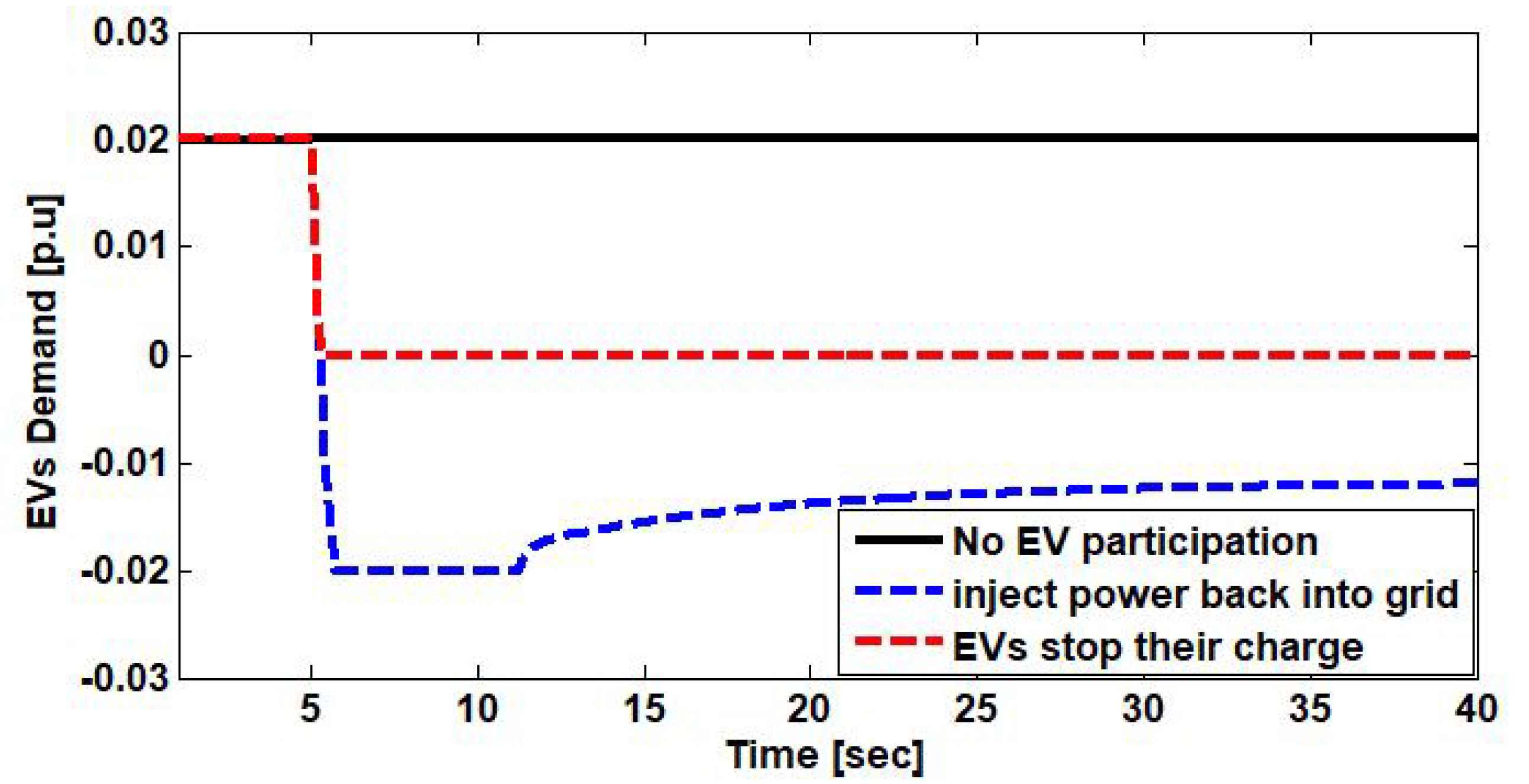
| Classification of EV | L7e | M1 | N1 | N2 |
|---|---|---|---|---|
| EV charging power [kW] | 3 | 3 | 3 | 10 |
| EV battery capacity [kWh] | 15 | 72 | 40 | 120 |
© 2020 by the authors. Licensee MDPI, Basel, Switzerland. This article is an open access article distributed under the terms and conditions of the Creative Commons Attribution (CC BY) license (http://creativecommons.org/licenses/by/4.0/).
Share and Cite
Alhelou, H.H.; Siano, P.; Tipaldi, M.; Iervolino, R.; Mahfoud, F. Primary Frequency Response Improvement in Interconnected Power Systems Using Electric Vehicle Virtual Power Plants. World Electr. Veh. J. 2020, 11, 40. https://doi.org/10.3390/wevj11020040
Alhelou HH, Siano P, Tipaldi M, Iervolino R, Mahfoud F. Primary Frequency Response Improvement in Interconnected Power Systems Using Electric Vehicle Virtual Power Plants. World Electric Vehicle Journal. 2020; 11(2):40. https://doi.org/10.3390/wevj11020040
Chicago/Turabian StyleAlhelou, Hassan Haes, Pierluigi Siano, Massimo Tipaldi, Raffaele Iervolino, and Feras Mahfoud. 2020. "Primary Frequency Response Improvement in Interconnected Power Systems Using Electric Vehicle Virtual Power Plants" World Electric Vehicle Journal 11, no. 2: 40. https://doi.org/10.3390/wevj11020040
APA StyleAlhelou, H. H., Siano, P., Tipaldi, M., Iervolino, R., & Mahfoud, F. (2020). Primary Frequency Response Improvement in Interconnected Power Systems Using Electric Vehicle Virtual Power Plants. World Electric Vehicle Journal, 11(2), 40. https://doi.org/10.3390/wevj11020040







